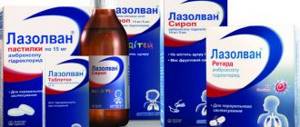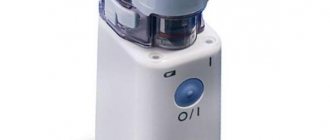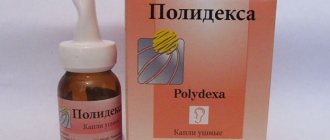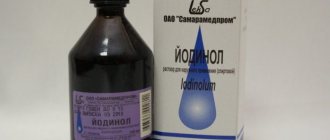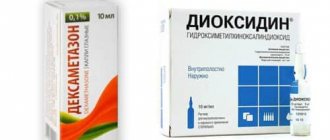Important! At a dosage of 125 mg, it is necessary to additionally add 1-2 ml of saline solution to the drug in the nebulizer.
To treat a long, debilitating cough, doctors prescribe antibiotics. There are drugs that help solve the problem without harming the entire body. These drugs include the antibiotic Fluimucil IT, which acts on the site of the disease locally, using inhalation.
Antibiotic Fluimucil IT for inhalation
The drug has no analogues in the complex treatment of respiratory diseases, because it simultaneously has an antimicrobial and expectorant effect. Carrying out inhalations using a nebulizer helps deliver the drug in finely dispersed form to the problem area. Antibiotic Fluimucil IT:
- acts locally;
- moisturizes the mucous membrane;
- thins mucus;
- simplifies its removal;
- improves sputum secretion;
- promotes expectoration;
- cleanses the bronchi;
- acts anti-inflammatory.
penetrates deeply;
Often, to solve problems of the nasal cavity, Rinofluimucil spray is used, which has an anti-inflammatory effect. If the cause of the disease is viruses, and the respiratory tract disease is accompanied by a cough, the antibiotic Fluimucil IT is prescribed for inhalation. Thanks to its local effect, it does not harm the entire body. With the help of medicine, drainage in tuberculosis is improved. It is used to prevent complications after operations. Diseases treated with antibiotics:
- bronchitis;
- pneumonia;
- tracheitis;
- cystic fibrosis;
- broncholitis;
- sinusitis;
- sinusitis;
- otitis.
Composition of the medicine
Fluimucil-antibiotic IT for inhalation is a complex combination product that has an active ingredient - thiamphenicol glycinate acetylcysteinate. It is produced in the form of a lyophilisate - a powder of a special preparation technology. The kit consists of an ampoule with an active substance that has a sulfurous odor, dosage of 250 ml, 500 ml. To dilute the antibiotic, the package contains special bottles of water.
Pharmacology of the active components of the drug
Each of the main active components of Fluimucil-antibiotic IT for inhalation is aimed at solving its own problems. The substance thiamphenicol is not used independently, in its pure form. It prevents the proliferation of harmful microorganisms by blocking protein synthesis in cell walls. Acts on different types of bacteria:
- E. coli;
- staphylococci;
- hemophilus influenzae;
- pneumoniae streptococcus;
- corynebacteria.
Another component that is included in Fluimucil-antibiotic IT for inhalation is acetylcysteine, a strong expectorant that helps thiamphenicol penetrate into tissues. With his help:
- the ability of bacteria to attach to the mucous membrane decreases;
- the proliferation of microorganisms is inhibited;
- sputum thins;
- its separation and removal is facilitated.
What does Fluimucil help with?
It is known that Fluimucil is a mucolytic. This medicine helps remove mucus, significantly thinning it. The main active ingredient of the drug is acetylcysteine, which affects the upper respiratory tract as follows:
- enhances the production of mucous secretions;
- thoroughly cleanses the nasal cavities and bronchi;
- thins mucus in the upper part of the trachea, paranasal sinuses, bronchi;
- has an anti-inflammatory effect by activating cells of the immune system.
The medication is prescribed in two forms:
- Fluimucil: ampoules (3 ml) with solution (10%) for inhalation;
- Fluimucil antibiotic IT: 250 ml or 500 ml bottle (the kit includes ampoules with sterile liquid intended for preparing an inhalation solution).
The medicine is used for the following health problems:
- for bronchitis (acute or chronic forms);
- laryngitis;
- tracheitis;
- rhinitis;
- sinusitis;
- pneumonia.
- Bulgur - what kind of grain is it? Delicious recipes and how long to cook bulgur in a saucepan or slow cooker
- How to change tariff on Beeline
- Fillings for pies made from yeast dough
Contraindications to the use of Fluimucil for inhalation:
- spasms in the bronchi - attacks of suffocation that sometimes appear in the patient;
- risk of pulmonary hemorrhage;
- stomatitis;
- blood diseases;
- Do not take during pregnancy or breastfeeding;
- chronic problems with the functioning of the kidneys and liver;
- child's age up to 3 years;
- a course of treatment with antibacterial agents, which was completed less than six months ago.
Fluimucil - instructions for use for inhalation
When using an antibiotic for inhalation, it is necessary that the doctor prescribe the treatment, taking into account the course of the disease and the age of the patient. For the product to work effectively you need:
- purchase medicine with the required dosage;
- choose the right inhaler for the procedures;
- dilute Fluimucil antibiotic taking into account the dosage;
- conduct the required number of sessions.
Selection and preparation of a nebulizer
Inhalations with Fluimucil IT are carried out using a nebulizer, which finely sprays the antibiotic, delivering it to the most remote areas of the diseased organ. When choosing a device for procedures, you need to keep in mind that the ultrasonic version of the device cannot be used. This is due to the fact that in nebulizers of this design the antibiotic is destroyed. This effect is produced by ultrasonic waves, which ensure atomization of the drug. It is recommended to use compressor devices in which the size of small droplets can be adjusted.
Before using the nebulizer you should:
- disinfect the device;
- Wash the hands;
- prepare a mask for breathing through the nose;
- make a solution for inhalation;
- pour the antibiotic into a special container using a pipette or syringe;
- mask, attach the compressor after filling the medicine.
How to dilute Fluimucil solution
For adults and children, the preparation of the solution is no different. Fluimucil-antibiotic IT for inhalation has a difference only in dosage. The solution is diluted in a glass container. For children, you should take half the amount of powder. The finished product should be stored on the refrigerator shelf for no more than a day. Adults require:
- take 500 ml of powder in an ampoule;
- add 4 ml of clean water from the kit;
- use the solution in 2 doses.
Find out what dry cough syrup is and how to take it correctly for adults and children.
The procedure for inhalation with Fluimucil IT
How to take Fluimucil IT in the form of inhalations? Please note:
- you cannot self-medicate;
- simultaneous use of other antibiotics is contraindicated;
- Do not take medications that suppress cough;
- the patient must breathe through the nose; if it is blocked, use vasoconstrictor drops;
- At least six months must have passed since the previous antibiotic treatment.
Fluimucil antibiotic for inhalation is prescribed by a doctor. He determines the treatment regimen, the number of procedures per day - this depends on the severity of the disease. The course lasts no more than 10 days. Inhalation is carried out 1.5 hours after a meal, lasting 15 minutes. During the procedure:
- Elevated temperature is not allowed;
- the patient's condition should be calm;
- inhalations and exhalations are made deeply and evenly through the nose.
The cause of various diseases of the ENT organs and respiratory tract are viral and infectious factors caused by bacteria or fungi. Their symptoms, in addition to fever, will be a runny nose and cough, so antibiotics must be used in treatment.
Such drugs are prescribed not only to adults, but also to children. Since the child’s immune system is not yet sufficiently developed, the disease can quickly become severe and cause complications. The drug Fluimucil has proven itself well. It is widely used for the treatment of cough in pediatric and adult therapy.
Instructions for use of the antibiotic Fluimucil for inhalation
Inhalations using Fluimucil are an effective way to get rid of troubles associated with respiratory tract diseases and their symptoms. During the treatment process, you can notice that after just a few inhalations the amount of bronchial secretion increases sharply. If therapy for cough and other signs of the disease is carried out correctly, then copious sputum production begins. The nuances of inhalation with Fluimucil depend on what type of drug is chosen.
How to make a solution for inhalation
Nebulizer solutions with Fluimucil must be prepared correctly, otherwise we simply will not get the desired effect:
- It is necessary to carefully open the ampoule with the drug, dilute its contents with saline or boiled water (1 to 1).
- It is allowed to prepare the mixture for inhalation only in a glass container, because, for example, aluminum containers “negate” the effect of acetylcysteine.
- Classic Fluimucil is used in the same dosages for children and adults: 1 ampoule per inhalation.
The mixture for inhalation into a nebulizer from the IT antibiotic Fluimucil is made a little differently:
- The powder is diluted with a sterile liquid, which is already included in the package with the drug.
- The contents of one bottle are diluted with water (8 ml).
- Children's dose: 2 ml of the resulting mixture per procedure.
- The antibiotic should not be diluted above the norm, because treatment with such a solution will be ineffective.
- The resulting mixture should be used immediately after preparation.
- What to ask a guy in correspondence, the best topics for communication
- Sunglasses with prescriptions
- What vitamins to take when losing weight
How to use a nebulizer
Inhalations with Fluimucil for children and adults using a nebulizer are one of the most effective methods of therapy, which is based on the administration of the drug through the respiratory tract. It must be remembered that the medicinal mixture cannot be placed in an ultrasonic nebulizer, because it quickly destroys the active substance Fluimucil. It is advisable to purchase a compressor device for inhalation, which provides an ideal setting for the size of the inhaled particles of the drug. You can use the unit (Omron) or B.Well.
Before adding Fluimucil for a cough to an inhaler, for bronchitis or sore throat, you should make sure that the patient is able to breathe normally through the nose. In another situation, it is recommended to drip the nose with vasodilating drops to restore normal breathing. Inhalation with Fluimucil should be carried out at least an hour and a half after eating. The patient's body temperature should be no more than 37.5 degrees.
Procedure:
- Pour the solution into the inhaler.
- To correctly calculate the volume of the drug, you must always take into account the fact that a small amount of the mixture remains on the walls of the device.
- Dosage for children's inhalation with Fluimucil is 1 ml, for adults – 2 ml.
- Inhalation is very simple: you need to inhale and exhale particles of the drug through the nose, breathing should be smooth and calm.
- One therapy session lasts 15-20 minutes.
- How many times a day should I refill and use the nebulizer? This depends on the degree and type of disease, as well as on the recommendations of the attending physician.
Composition of Fluimucil and principle of action
Fluimucil is available in 3 ml ampoules, which contain a 10% solution for inhalation with the active substance acetylcysteine (300 ml). Excipients are: disodium edate, sodium hydroxide and purified water.
The drug acts as a mucolytic, therefore it helps to liquefy and expectorate sputum. Fluimucil affects the body as follows:
- thins mucus, reducing its viscosity;
- softens the mucous membrane;
- influencing the secretion of the bronchi, promotes the rapid discharge of mucus;
- by stimulating the immune system, it reduces the inflammatory process in the lungs and nasopharynx.
Vials of Fluimucil - IT antibiotic with lyophilisate in a dosage of 250 ml and 500 ml additionally contain thiamphenicol, which has an antibacterial effect. Therefore, in addition to the above properties, it also affects bacteria, destroying and slowing down their reproduction. This dosage form comes with ampoules of water for injection.
Composition and properties
Fluimucil in solution for injection and inhalation is available in 3 ml ampoules containing the active substance acetylcysteine 100 mg per 1 ml; one package contains 5 ampoules. This drug is a synthetic mucolytic intended for parenteral and inhalation administration. Acetylcysteine has the following medicinal properties:
- increased mucus production in the respiratory tract;
- moisturizing and softening the inflamed mucous membrane;
- liquefaction of thick respiratory tract secretions;
- relief of local inflammatory reaction;
- activation of local immune defense cells;
- antioxidant effect;
- cleansing the bronchi from thick mucus and the paranasal sinuses from viscous secretions.
In addition to the usual Fluimucil, which contains acetylcysteine, a dosage form is also available with the addition of the antibacterial substance Thiamphenicol, this drug is called Fluimucil-Antibiotic.
It is available in powder form, which, when diluted with boiled water or saline, can also be used as an inhalation solution for bacterial inflammatory processes in the lower respiratory tract and paranasal sinuses.
You may also be interested in: The effectiveness of inhalation therapy for laryngitis
Indications for use
According to the instructions, Fluimucil IT is prescribed by the attending physician for wet and dry cough, when sputum discharge is impaired.
It is used in the treatment of:
- bronchitis and bronchiolitis;
- tracheitis;
- pneumonia;
- tuberculosis;
- laryngitis;
- laryngotracheitis;
- purulent otitis;
- sinusitis;
- sinusitis;
- in preparation for and after surgery.
Most often, the product is recommended for use as inhalation. This method is especially widely used for coughs in children. It can also be used for injections if the doctor considers this method of treatment necessary.
Inhalation use of the drug is prescribed:
- children 2-3 years old at a dosage of 125 mg (1/4 bottle);
- for acute illness from 3 to 11 years, 250 mg (1/2 bottle) during the first three days, and then 125 mg;
- from 12 years old - 500 mg (1 bottle) once a day, and if prescribed 2 times a day, then the bottle is divided in half.
The dosage of Fluimucil and the frequency of inhalations are determined by the attending physician
Video
The video talks about how to quickly cure a cold, flu or acute respiratory viral infection.
Opinion of an experienced doctor. We suggest you read: Why the pancreas does not produce insulin
We have already mentioned that the diseases for which Fluimucil inhalation solutions are used include pathologies of the upper and lower respiratory tract. Let's try to list these diseases:
- chronic pulmonary emphysema;
- acute and chronic bronchitis;
- chronic asthmatic bronchitis;
- pulmonary tuberculosis;
- bronchiectasis;
- pneumonia;
- pulmonary complications of cystic fibrosis;
- primary pulmonary amyloidosis;
- chronic obstructive pulmonary disease (COPD);
- pulmonary fibrosis.
In addition, inhalations with Fluimucil are used during the rehabilitation treatment of postoperative patients, anesthesia, and post-traumatic conditions. The instructions for inhalation Fluimucil indicate that the drug is also used to prepare for some diagnostic tests.
Fluimucil antibiotic solution is also used for the treatment of otitis - both catarrhal and purulent - sinusitis, pharyngitis and laryngitis, but for this purpose the drug is used topically and not inhaled.
Fluimucil is a fairly safe medicine. It is contraindicated only in case of individual sensitivity to the active substance, acetylcysteine, as well as thiamphenicol in the case of a combined drug.
The combination of Fluimucil with thiamphenicol is also contraindicated in cases of changes in the blood picture: anemia, leukopenia and a decrease in the number of platelets.
Prescribing Fluimucil in any form, including inhalation, during pregnancy is associated with some risk, which is associated with the lack of studies of the drug’s effect in this category of patients.
Thus, during studies on rabbits, pregnant females were administered 500 mg of the drug per kilogram of body weight per day. The result of the experiment proved the complete absence of a teratogenic effect.
However, despite encouraging animal experiments, doctors prefer not to prescribe acetylcysteine preparations, including inhaled forms of Fluimucil, during pregnancy. The drug belongs to category B and is used in cases where the benefit to the woman outweighs the possible risk to the child. The same restriction has been established for acetylcysteine in combination with thiamphenicol.
Studies of the effect of acetylcysteine during breastfeeding have also not been conducted. Moreover, it is not known whether Fluimucil is absorbed into breast milk. Therefore, when treating nursing women, it is better to give preference to safer drugs with proven safety. But Fluimucil-antibiotic IT for inhalation is officially contraindicated during breastfeeding.
For inhalation treatment of respiratory tract diseases, a 10% solution of Fluimucil is used, intended for both injection and inhalation administration.
The dosage of Fluimucil for inhalation is the same for both adults and children. The drug is taken in doses of 300 mg, which are contained in one ampoule of a 10% solution of Fluimucil. The medicine should not be dissolved in water or saline solutions; the form is already completely ready for use.
The average course involves 5–10 days of inhalation therapy with Fluimucil. In the treatment of severe chronic pathologies of the bronchopulmonary system, the use of the drug for up to six months is quite acceptable.
Fluimucil antibiotic IT is also used for nebulizer therapy. However, unlike the form with acetylcysteine, this drug is available in powder form. How to prepare Fluimucil antibiotic for inhalation? Very simple.
The dose of Fluimucil antibiotic for adults is 250 mg 1-2 times a day, and for children - 125 mg for each inhalation 1-2 times a day. The course of treatment should not last more than 10 days.
How to dilute an antibiotic for inhalation?
Fluimucil is diluted for use in various inhalers. Maximum effectiveness can be achieved by using a compression nebulizer, which sprays the medicinal substance into the smallest fractions. The preparation of solutions with Fluimucil and Fluimucil, an IT antibiotic, have slight differences.
To use a nebulizer with Fluimucil solution, the product must be diluted as follows:
- the ampoule with the drug is carefully opened and diluted in a 1:1 ratio with boiled or specially purified water for injection;
- the solution is prepared in a glass container, since the material of the container may react with the active substance of the drug and weaken its functions;
- The dosage for children and adults is the same, so the procedure uses 1 ampoule per 1 inhalation.
Fluumicil - an antibiotic IT for inhalation is done as follows:
- the contents of 1 bottle are diluted with 8 ml of water for injection, which is included in the kit;
- for inhalation of a child, use 2 ml of the resulting solution;
- the resulting solution is used only immediately after preparation.
Instructions for use
It is necessary to prepare for treatment with the drug by inhalation. To do this, the nasopharynx is cleared of accumulated mucus. For difficult nasal breathing, vasoconstrictor drops are used. Food is consumed one hour before the procedure. During inhalation, a person should arrive in a calm state, and his body temperature should not exceed 37.5 degrees.
We dilute the Fluimucil solution according to the scheme for a compression nebulizer, pour it into a special hole, put on a plastic mouthpiece and begin to calmly and slowly inhale the vapors. This method is used for inpatient treatment, but can also be effectively used at home.
Side effects and contraindications
When using any medications there are always risks, so in no case should you prescribe treatment without permission, especially when it comes to children. The drug Fluimucil also has a number of contraindications. The doctor will not prescribe it if:
- allergies to components included in the composition;
- ulcer of the duodenum or stomach, especially during an exacerbation of the disease;
- anemia;
- leukopenia;
- renal and liver failure;
- thrombocytopenia.
The drug has its contraindications and side effects, so it should be used only as prescribed by a doctor.
Considering the risks, Fluimucil is used under the strictest medical supervision in pregnant women, lactating women and children in the first two years of life. Inhalation treatment with Fluimucil can cause side effects, the most common of which are:
- obstructive allergic cough;
- sore throat;
- vomiting reflex;
- stomatitis;
- rhinorrhea.
If any ailments occur during or immediately after using inhalations with the drug, treatment should be stopped and seek qualified help from a doctor. In severe cases, an ambulance is immediately called.
How much does the drug cost and are there any analogues?
If the patient experiences any ailments or side symptoms during treatment, the doctor will replace the drug with a similar one that is more suitable for the patient. It should be noted that Fluimucil, an IT antibiotic, is an original, irreplaceable drug for which there are no analogues yet. Its price in pharmacies varies from 415 to 930 rubles.
Instead of Fluimucil, therapists and pediatricians in most cases prescribe: ACC injection (10%), Mucomist (20%), Acysteine, Lazolvan. These drugs have an expectorant effect and are in the same price category, therefore they are interchangeable.
Instructions for use of Fluimucil for inhalation
What does Fluimucil help with?
It is known that Fluimucil is a mucolytic. This medicine helps remove mucus, significantly thinning it. The main active ingredient of the drug is acetylcysteine, which affects the upper respiratory tract as follows:
- enhances the production of mucous secretions;
- thoroughly cleanses the nasal cavities and bronchi;
- thins mucus in the upper part of the trachea, paranasal sinuses, bronchi;
- has an anti-inflammatory effect by activating cells of the immune system.
The medication is prescribed in two forms:
- Fluimucil: ampoules (3 ml) with solution (10%) for inhalation;
- Fluimucil antibiotic IT: 250 ml or 500 ml bottle (the kit includes ampoules with sterile liquid intended for preparing an inhalation solution).
The medicine is used for the following health problems:
Contraindications to the use of Fluimucil for inhalation:
Instructions for use of the antibiotic Fluimucil for inhalation
How to make a solution for inhalation
Nebulizer solutions with Fluimucil must be prepared correctly, otherwise we simply will not get the desired effect:
The mixture for inhalation into a nebulizer from the IT antibiotic Fluimucil is made a little differently:
How to use a nebulizer
Before adding Fluimucil for a cough to an inhaler, for bronchitis or sore throat, you should make sure that the patient is able to breathe normally through the nose. In another situation, it is recommended to drip the nose with vasodilating drops to restore normal breathing. Inhalation with Fluimucil should be carried out at least an hour and a half after eating. The patient's body temperature should be no more than 37.5 degrees.
Marina, 26 years old: She suffered from such an unpleasant disease as sinusitis. I was constantly sick once a month. I tried a large number of remedies, but the disease still returned. A doctor I know advised me to use an inhaler filled with the antibiotic Fluimucil. 5 sessions were enough for significant relief. The third month went by, but there was no sinusitis.
The information presented in the article is for informational purposes only. The materials in the article do not encourage self-treatment. Only a qualified doctor can make a diagnosis and make recommendations for treatment based on the individual characteristics of a particular patient.
Some reception features
Inhalations using Fluimucil are an effective way to get rid of troubles associated with respiratory tract diseases and their symptoms.
During the treatment process, you can notice that after just a few inhalations the amount of bronchial secretion increases sharply. If therapy for cough and other signs of the disease is carried out correctly, then copious sputum production begins. The nuances of inhalation with Fluimucil depend on what type of drug is chosen.
Nebulizer solutions with Fluimucil must be prepared correctly, otherwise we simply will not get the desired effect:
- It is necessary to carefully open the ampoule with the drug, dilute its contents with saline or boiled water (1 to 1).
- It is allowed to prepare the mixture for inhalation only in a glass container, because, for example, aluminum containers “negate” the effect of acetylcysteine.
- Classic Fluimucil is used in the same dosages for children and adults: 1 ampoule per inhalation.
The mixture for inhalation into a nebulizer from the IT antibiotic Fluimucil is made a little differently:
- The powder is diluted with a sterile liquid, which is already included in the package with the drug.
- The contents of one bottle are diluted with water (8 ml).
- Children's dose: 2 ml of the resulting mixture per procedure.
- The antibiotic should not be diluted above the norm, because treatment with such a solution will be ineffective.
- The resulting mixture should be used immediately after preparation.
Inhalations with Fluimucil for children and adults using a nebulizer are one of the most effective methods of therapy, which is based on the administration of the drug through the respiratory tract. It must be remembered that the medicinal mixture cannot be placed in an ultrasonic nebulizer, because it quickly destroys the active substance Fluimucil.
It is advisable to purchase a compressor device for inhalation, which provides an ideal setting for the size of the inhaled particles of the drug. You can use the unit (Omron) or B.Well.
Before adding Fluimucil for a cough to an inhaler, for bronchitis or sore throat, you should make sure that the patient is able to breathe normally through the nose. In another situation, it is recommended to drip the nose with vasodilating drops to restore normal breathing.
Procedure:
- Pour the solution into the inhaler.
- To correctly calculate the volume of the drug, you must always take into account the fact that a small amount of the mixture remains on the walls of the device.
- Dosage for children's inhalation with Fluimucil is 1 ml, for adults – 2 ml.
- Inhalation is very simple: you need to inhale and exhale particles of the drug through the nose, breathing should be smooth and calm.
- One therapy session lasts 15-20 minutes.
- How many times a day should I refill and use the nebulizer? This depends on the degree and type of disease, as well as on the recommendations of the attending physician.
Fluimucil
The manufacturer of Fluimucil, the Italian pharmaceutical company Zambon, produces 14 different forms of the drug, and a special place among them is occupied by solution for injection and inhalation. It is used for nebulizer treatment.
The effectiveness of Fluimucil's active ingredient, acetylcysteine, has been fully proven and is based on the chemical structure of the molecule. The sulfhydryl group contained in acetylcysteine can “break” disulfide bonds that connect protein molecules (mucoproteins) present in mucus. This reduces the viscosity of sputum.
Another active substance that is part of Fluimucil-antibiotic-IT, thiamphenicol, is active against various bacteria, including pneumonia streptococci, staphylococci, Haemophilus influenzae, Klebsiella, Neisseria and other microorganisms. These bacteria are most often the causative agents of respiratory tract diseases.
The combination of thiamphenicol and acetylcysteine is particularly stable: the mucolytic prevents the destruction of the unstable antibiotic. This ensures the long-term complex effect of the inhalation drug containing a complex of active ingredients - the antibiotic Fluimucil.
Fluimucil for inhalation has undeniable advantages over oral, that is, internal dosage forms, and patient reviews confirm this. The smallest dispersed particles of the active substance, which are formed with the help of modern nebulizers, can penetrate into the lower parts of the respiratory tract.
Acetylcysteine and thiamphenicol, which are delivered to the site of the inflammatory process, begin to act in the highest possible concentration. Indeed, in contrast to the inhalation route of administration, when administered orally, the bioavailability of the active substances is extremely low.
We invite you to familiarize yourself with: Strips for glucometer control plus
There is even such a thing as the “first pass” effect: acetylcysteine entering the gastrointestinal tract is retained in the liver, as a result of which its bioavailability does not exceed 10%. This means that the vast majority of oral Fluimucil that enters the body does not enter the bloodstream and target organs - the bronchi and lungs.
In addition, inhaled solutions of Fluimucil and Fluimucil-antibiotic IT begin to work twenty times faster than internal ones. This quality is important, especially in situations that require immediate treatment.
With the inhalation administration of Fluimucil, the likelihood of gastrointestinal side effects characteristic of acetylcysteine preparations is practically eliminated. Adverse events that occur after inhalation with Fluimucil include:
- reflex cough;
- local irritation of the upper respiratory tract;
- inflammation of the oral mucosa - stomatitis;
- rhinitis (inflammation of the nasal mucosa);
- drowsiness.
Particular attention should be paid to the potential for a rather serious adverse effect - bronchospasm. It can also occur with internal use of acetylcysteine, but inhalation administration significantly increases the risk of respiratory dysfunction.
Experimental evidence suggests that bronchospasm may occur almost unpredictably in some patients. If bronchospasm occurs, bronchodilators (for example, Salbutamol) are immediately prescribed.
In patients prone to such adverse effects, the risk of respiratory impairment usually outweighs the benefit of inhaled Fluimucil. Therefore, in such cases, it is advisable to select an alternative mucolytic.
However, you should not be afraid ahead of time and wait with horror for an attack. Bronchospasm during the use of Fluimucil occurs quite rarely, even in patients with asthmatic bronchitis and bronchitis due to complications of bronchial asthma.
The combined inhaled antibiotic Fluimucil, in addition to the side effects characteristic of acetylcysteine, can additionally cause stomatitis, nausea and rhinitis.
Inhalations with Fluimucil are a very effective mucolytic agent. Already during the course of treatment, a fairly sharp increase in the volume of liquefied bronchial secretions may occur. The main sign of achieving a result is the appearance of a productive, perhaps quite frequent, cough reflex.
And then special care should be taken by parents of small children, as well as patients with a history of bronchospasm. After all, the risk of irritation of the respiratory tract and the appearance of breathing problems during treatment with Fluimucil increases.
If you are taking antibiotics simultaneously with inhalation or any other treatment with Fluimucil, it is important to take into account one more feature of the drug. The fact is that some antibacterial agents can react with acetylcysteine.
- antibiotics of the tetracycline group (except Doxycycline) - Tetracycline, Ofloxacin;
- Ampicillin;
- Amphotericin B.
If you are prescribed these medications, then at least two hours should pass between the time of taking them and inhalation with Fluimucil.
There are no substitutes for the IT antibiotic Fluimucil - the drug is original, and not a single manufacturer has yet released its generic version. There are few analogues of Fluimucil inhalation solution, but they exist. These include:
- ACC injection, 10% solution for injection and inhalation from Hexal;
- Mucomist, solution for inhalation 20% produced by the British corporation Bristol Myers.
Note that both Fluimucil and its substitutes belong to approximately the same price category, and the quality of all analogues fully complies with all European standards. Therefore, treatment with inhaled forms of both Fluimucil and its analogues is affordable, safe and very effective.
Acetylcysteine belongs to the group of mucolytic drugs. It is able to break disulfide bonds between mucopolysaccharides of sputum, which leads to a decrease in viscosity and an increase in mucus volume.
As a result, damage to healthy cells decreases and the severity of the inflammatory process decreases. The maximum concentration is reached 3 hours after taking acetylcysteine. The drug is excreted from the patient's body in the form of inactive metabolites in the urine.
Thiamphenicol is a synthetic antibiotic from the amphenicol group. The mechanism of action is associated with disruption of protein synthesis in the cells of pathogenic bacteria.
We suggest you read: What the pancreas likes from food and what foods to eat
It has a bacteriostatic effect on the following microorganisms, which are the most common pathogens of respiratory tract infections in humans:
- hemophilus influenzae;
- Klebsiella;
- Neisseria;
- corynebacterium;
- streptococcus;
- staphylococcus;
- some anaerobic bacteria.
Fluimucil for inhalation: preparation of solution and procedure
Composition and properties of Fluimucil
Fluimucil is an effective antibiotic that has mucolytic properties.
This drug belongs to mucolytics (drugs that actively thin sputum). This solution for inhalation is based on the active component acetylcysteine. Among the auxiliary components of the medicine are sodium hydroxide and disodium edatate, purified water.
Fluimucil has the following properties:
The drug is available in various pharmaceutical forms:
- Liquid for inhalation.
- Water for injections.
- Tablets for preparing an effervescent drink.
- Granules.
The solution for inhalation has the form of a colorless liquid with a specific sulfur odor. It is contained in ampoules, which are placed in plastic holders.
Purpose of the drug
Fluimucil is prescribed for respiratory diseases, to improve sputum discharge
Fluimucil is prescribed as an inhalation for the treatment of infectious and inflammatory diseases of the upper and lower respiratory organs, the symptom of which is cough:
Also, indications for the use of Fluimucil are coughs due to acute respiratory infections or acute respiratory viral infections. In some cases, the drug is used to treat otitis media.
The antibiotic product is also effective for pulmonary cystic fibrosis, amyloidosis, fibrosis, tuberculosis, since it destroys staphylococci, Haemophilus influenzae, streptococci and other pathogens.
The drug can be used as a prophylactic agent to prevent unwanted complications in the postoperative period.
Preparation of the solution and carrying out the procedure
The dosage and course of treatment with inhalations with Fluimucil must be prescribed by a doctor!
There are several types of inhalation devices, but it is not advisable to use an ultrasonic device to use Fluimucil. A compressor nebulizer is best suited for the procedure using this product.
- In order to make a liquid for one procedure, take one ampoule of Fluimucil 10 percent, 3 ml (for adults).
- For young patients under six years of age, the drug is prescribed in a dosage of one milliliter.
- Up to 12 years - two milliliters.
Dilute the drug with saline or water in a 1:1 ratio. For children under two years of age, inhalation is performed only in a hospital setting.
Inhalation is recommended twice a day; the procedure lasts about 15 minutes.
The prepared solution can be placed in the refrigerator and used the next day. To do this, you just need to warm it up a little.
To prepare a solution with Fluimucil, an IT antibiotic, the powder is diluted with the liquid that is in the package. For one bottle take 8 milliliters of chilled boiled water. For children, use 2 milliliters of solution per inhalation.
More information about inhalations with Fluimucil can be found in the video:
Contraindications and side effects
Improper use or overdose of the drug may cause side effects.
This remedy should be used with caution for bronchial asthma, predisposition to pulmonary bleeding and spastic bronchitis. It is not advisable to use Fluimucil for acute peptic ulcers. Contraindications to the use of the drug with an antibiotic are liver failure and kidney pathologies. The inhalation agent is prescribed in minimal doses to elderly patients.
It is important to note that it is not advisable to combine inhalations with the drug with ampicillin or tetracycline.
Side effects of using inhalations with Fluimucil include:
Fluimucil's analogs
The following popular drug analogues have mucolytic properties:
They are safe and effective for coughs with difficult sputum. They are prescribed if there are contraindications to the use of Fluimucil or if side effects from its use occur.
Fluimucil antibiotic composition
The medicine consists of the antibiotic thiamphenicol and the mucolytic acetylcysteine. Thiamphenicol and acetylcysteine in this medicine are bound together into one molecule. This substance can be introduced into the body by aerosol or inhalation. The connection with acetylcysteine stabilizes the drug, allowing it to be stored longer without deteriorating.
To date, fluimucil antibiotic is the only antibiotic that can be administered into the body in this way. And this is not a topical drug. It penetrates well into the blood, providing a pronounced systemic antibacterial effect. But a particularly high concentration of it is created at the site of its administration - in the respiratory tract and mucus, which is very beneficial when the medicine is used to treat respiratory diseases.
In the respiratory tract, the drug is broken down into thiamphenicol (its own antibiotic) and acetylcysteine (mucolytic). Acetylcysteine improves the transport of the antibiotic to the lower respiratory tract and to microbes located in lumps of mucus inside the bronchi. Thus, the effect of the antibiotic is enhanced.
Antibiotic
Thiamphenicol is a broad-spectrum antibiotic. Its predecessor is chloramphenicol (chloramphenicol). According to the spectrum of action, thiamphenicol is close to chloramphenicol, but lacks its side effects (hepatotoxicity, inhibition of hematopoiesis, etc.)
Thiamphenicol is effective against the main bacterial pathogens of respiratory diseases in children: pneumococcus, streptococcus, Haemophilus influenzae, some strains of Staphylococcus aureus, Legionella, chlamydia, mycoplasma.
Thiamphenicol with this method of administration has less effect than other antibiotics on the intestinal microflora and does not irritate the stomach and intestines at all.
Acetylcysteine remarkably thins mucus and helps its removal, improves the penetration of the antibiotic into the mucus and into the small bronchi and alveoli. But mothers must remember that when using acetylcysteine, in order for the medicine to be effective, the child needs to drink plenty of fluids.
Indications and contraindications
Instructions for use of the drug contain detailed information regarding all cases when inhalations with Fluimucil are especially effective:
- All diseases of the respiratory system in which the formation of thick, poorly discharged sputum occurs:
- inflammation of the trachea and bronchi of various sizes (tracheitis, bronchitis, bronchiolitis);
- pneumonia (pneumonia, including chronic);
- bronchiectasis and chronic pulmonary obstruction;
- pulmonary form of cystic fibrosis;
- purulent destructive pneumonia and lung abscess;
- emphysema;
- laryngeal edema, laryngitis and laryngotracheitis;
- interstitial lung diseases;
- atelectasis (collapse) of a lobe of the lung due to blockage of a section of the bronchus by a mucus plug.
- Acute catarrhal and purulent otitis media.
- Acute sinusitis.
- Conditions after injuries and operations in which there is an accumulation of mucus in the respiratory tract.
- Preparatory measures before bronchoscopic, bronchographic examination, drainage of the bronchial tree.
- Therapeutic lavages during punctures of the maxillary sinuses, middle ear, as well as the nasal cavity and mastoid process during operations.
Inhalations with Fluimucil
Absolute contraindications for the use of the drug Fluimucil are:
- the presence of peptic ulcer of the stomach and duodenum (duodenum) in the acute stage;
- During pregnancy and breastfeeding;
- hypersensitivity, allergy to acetylcysteine.
Relative contraindications are:
- stomach and duodenal ulcers in remission;
- varicose veins of the lower part of the esophagus;
- suspicion of any bleeding from the respiratory tract, a history of hemoptysis;
- bronchial asthma (risk of developing bronchospasm);
- kidney and liver failure;
- adrenal diseases;
- arterial hypertension;
- the first 2 years of a child's life.
It will also be interesting: Inhalations in a nebulizer with Borjomi mineral water
This video will tell you in more detail about Fluimucil:
When is fluimucil antibiotic suitable for a child?
The pediatrician must prescribe the antibiotic Fluimucil to the child.
The drug can be used for rhinosinusitis, prolonged bacterial rhinitis, laryngotracheitis, tracheitis, bronchitis, bronchiolitis, cystic fibrosis, pneumonia.
When treating with this medicine, additional expectorant, antitussive, and mucolytic medications are not required.
Other antibiotics are also not prescribed with this drug.
This may reduce the effectiveness of the drug.


